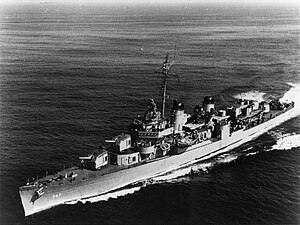USS Cowell (DD-547)
 USS Cowell (DD-547) underway, c. 1951
| |
| History | |
|---|---|
| Namesake | John G. Cowell |
| Builder | Bethlehem Shipbuilding Corporation, San Pedro, California |
| Laid down | 7 September 1942 |
| Launched | 18 March 1943 |
| Commissioned | 23 August 1943 |
| Decommissioned | 17 August 1971 |
| Stricken | 17 August 1971 |
| Fate | Transferred to Argentina, 17 August 1971 |
| History | |
| Name | Almirante Storni |
| Acquired | 17 August 1971 |
| Stricken | 1982 |
| Fate | Scrapped, 1982 |
| General characteristics | |
| Class and type | Fletcher-class destroyer |
| Displacement | 2,050 long tons (2,080 t) |
| Length | 376 ft 6 in (114.8 m) |
| Beam | 39 ft 8 in (12.1 m) |
| Draft | 17 ft 9 in (5.4 m) |
| Propulsion |
|
| Speed | 35 knots (65 km/h; 40 mph) |
| Range | 6,500 nmi (12,000 km) at 15 knots (28 km/h) |
| Complement | 273 |
| Armament |
|
USS Cowell (DD-547), a Fletcher-class destroyer, was the second ship of the United States Navy to be named for John G. Cowell (1785–1814).
Cowell was
Central Pacific campaigns
Sailing from San Pedro 28 October 1943, Cowell arrived at
Cowell returned to
After an overhaul at Eniwetok, Cowell put to sea 29 August 1944 with Task Group 36.5 (TG 38.5) for air strikes on the western
Battle of Okinawa
Returning to action, Cowell sailed from
Cowell sailed from Okinawa 20 September 1945 to support the occupation landings at Matsuyama. She cleared for home from Nagoya 31 October and arrived at San Diego 17 November, where Cowell was placed out of commission in reserve 22 July 1946.
1951 – 1960
Recommissioned 21 September 1951, Cowell was assigned to the
Cowell cleared Norfolk 7 January 1955 and arrived at
In addition to the Presidential Unit Citation, Cowell received 11
ARA Almirante Storni
On 17 August 1971, the ship was decommissioned, stricken from the U.S. Naval Vessel Register, and transferred to Argentina. She served in the Argentine Navy as ARA Almirante Storni.
In October 1975, the British Government tasked Lord Shackleton (son of the Antarctic explorer Sir Ernest Shackleton) with an economic survey of the Falkland Islands. The Argentine Government reacted furiously and refused permission for Shackleton to travel via Argentina. Later, on 4 February 1976, the ship transporting Shackleton to the islands, the RRS Shackleton, was fired upon by the Almirante Storni.[1] In 1982, she was stricken and scrapped.
References
- House of Commons. col. 1414–1417.
- This article incorporates text from the public domain Dictionary of American Naval Fighting Ships. The entry can be found here.
